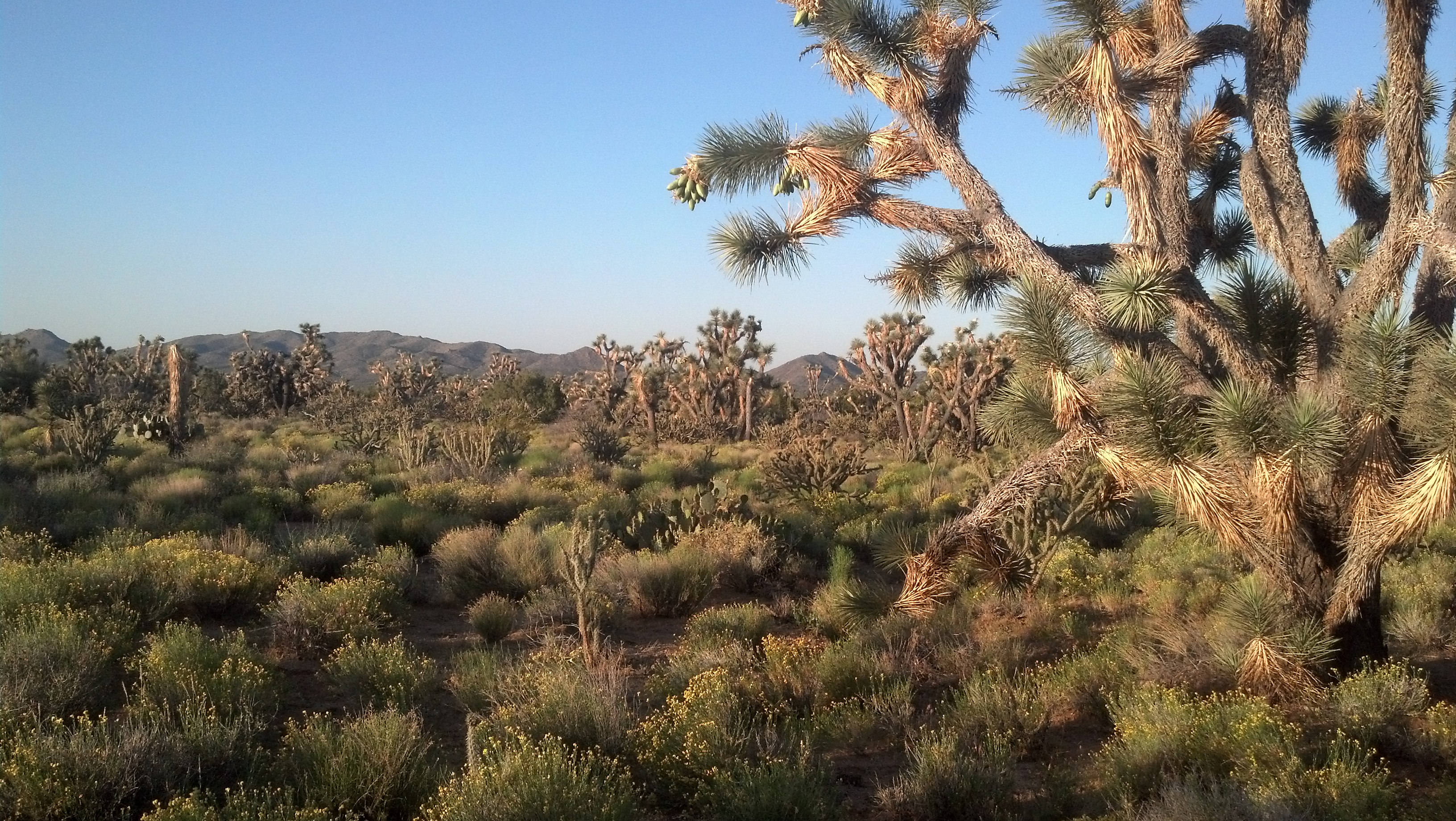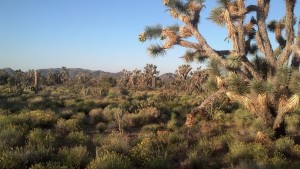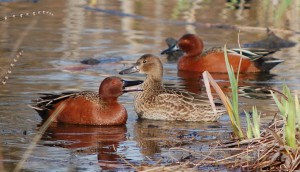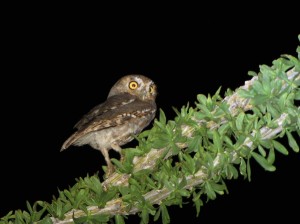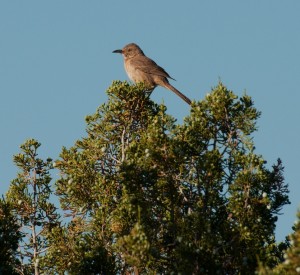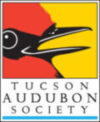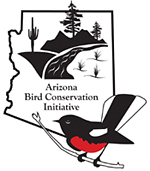Trip report by Craig Anderson for his Arizona IBA Big Year.
If solitude and serenity are what you are seeking for your next birding adventure, Joshua Tree IBA (one of Arizona’s newest important Bird Areas) is definitely a trip for you!
Two and a half hours north of Phoenix, off Highway 93 and immediately west of Wikieup, Joshua Tree IBA is like visiting the enchanted “Truffula” tree forest of The Lorax fame. The 30-40 foot Joshua trees are unique and spell binding with their variety of different shapes and twists. While the forest includes some open spaces, there are places where the Joshua trees are so numerous you can barely walk through them. Other parts of this mixed and robust desert forest include huge Juniper trees, Saguaro cactus, Spanish Dagger, Creosote,
Mesquite trees and numerous flowering plants.
I was joined on this trip by Terri Ratley, Arizona birder and adventurous camper. She was so appreciative of the opportunity to learn about Audubon’s IBA program first hand, that she gladly made a $25 donation to support the IBA program. The adventure started as we stopped for lunch at the rustic Wikieup Trading Post Restaurant. Angie, our waitress and local resident, enthusiastically shared her knowledge of Joshua Tree when we told her of our quest. She was surprised that the area she loves is now a designated “Important Bird Area” and destination for “Bird Watchers”. She came back frequently between serving other quests, to learn more about our desire to camp in the area. “It’s breathtaking and so quiet”, she said, and then asked in a concerned voice, if we had “four-wheel drive”, “It’s a must, there are some rough spots, especially if it rains”, she said.
Leaving our new friend, Terri and I followed her instructions to turn left off Hwy 93 just beyond the Chevron station. “Chicken Springs Road” was reasonably maintained but rutted and rocky; four-wheel drive sure smoothed out the bumps. After a couple of miles, we encountered on the right the white “Sign-In/Out” station. While there are no fees to enter, you must register your car, date in & out plus the purpose of your visit. During hunting season, the area is used by hunters seeking Mule Deer, Javelina, Gambel’s Quail and ducks that visit the ponds. ATV’ers are permitted to use the main roads and trails. “Offroad” travel is not permitted.
After reading the regulations, I prominently displayed the temporary pass from my rearview mirror. We then proceeded 13 miles toward the intersection with “Alamo Lake Road”. At the intersection stood a classic, large steel frame windmill, one of many we would see in Joshua Tree. The water tanks are owned by local ranchers, most prominently the “Bar S” ranch. Signage clearly says you are welcome to visit these areas but “on foot” only.
Most of these areas are short hikes to good birding. West of the intersection’s windmill is a stock tank where we had our first surprise – four Cinnamon Teal dabbling on the pond. We also observed Roughwinged Swallows swooping down to take insects emerging from the water, Turkey Vultures, Western Red-Tails, Cooper’s, three spectacular Harris Hawks and a single Wilson’s Snipe.
Looking for a campsite, we followed a rough trail that started just south of the intersection and headed west. It didn’t take long for us to find ourselves among big, bold and uniquely formed Joshua trees, along with massive Juniper trees, Yucca, Prickly Pear and Spanish Dagger. The land here is mostly owned by BLM and therefore offers remote camping without fees. There is no water or services. You need to be completely self-sufficient including trash bags for your waste.
Our campsite included a forty foot plus Joshua two feet in diameter and a massive companion Juniper Tree that provided some shade. We set up our minimalist camp that did include however, a “tent toilet”. I try not to leave anything except our foot prints, packing up all trash and waste. Other campers seem to share the same values as we saw very little trash throughout the IBA.
Our first birding activity was a dusk visit to the adjacent water tank. While the water tank and surrounding habitat provided some good birding, the stock pens throughout the IBA were the most productive. Around these, we got good looks at Lucy’s Warblers, Say’s Phoebe’s, Brewer’s, Black-throated, Whitecrowned Sparrows and numerous finches such as House and Lesser Goldfinches.
Our first night, while sitting around my gas fire ring, brought us what turned out to be the highlight of our trip … the trifecta… Great Horned, Western Screech and the diminutive Elf Owl. They all quickly responded to my playback of the Western calls. While the Western Screech Owls provided the larger and most sustained chorus, the Great Sonoran Desert Borderlands IBA Horned and Elf Owl could be heard periodically throughout the evening. A single Elf Owl responded to my 6:00 AM playback the following morning. The most striking event each day was the dawn chorus of Bendire’s Thrashers that surrounded our camp site. I found Joshua Tree one of the best places to study the Bendire’s behaviors and calls.
There are 78 resident and migrating birds listed for the IBA, 10 of which have conservation status. I suspect however, that as more birders visit the area in the coming years, more species will be added.
Persistent in our birding efforts, we were rewarded by getting most of the “conservation status” species along with many others. Owling at night along the road to our camp and visits to the adjacent stock pen was a special treat. We had a beautiful 3/4 Moon to provide light for our footsteps.
Over the next two days, we drove approximately 14 miles exploring the roads and marked trails. I was extremely pleased we had four-wheel drive as we often encountered rough and sandy spots. Occasionally, we had to back up, as the trail became too treacherous to proceed. We walked a total of 3-4 miles to the various water tanks and stock pens. There were only a few other campers in the area. Our closest neighbors were over a half-mile from us. We never heard them! The ATV’ers were respectful and usually traveled the main roads.
At slightly over 3,000 feet in elevation, I will visit this special Mojave Desert IBA many more times during October-May. It features easy access to remote camping, the uniqueness of the Joshua tree forest and good birding. The solitude and serenity provide what my soul needs the most to be renewed, centered and made whole.
Editor’s note: Joshua Tree IBA is also an excellent habitat for Bendire’s Thrashers and was recently granted Global IBA status because of this bird.

